Introduction: Why Oracle Cards Are More Than Just Pretty Pictures
Most people think of oracle cards as “tarot’s little sister”—gentler, simpler, maybe even decorative. But to dismiss them as just pretty cards is like saying books are just paper and ink. Oracle cards are living tools of intuition. They can confirm what you feel, highlight what you’re missing, and open spiritual dialogue that goes deeper than casual advice from friends.
Here’s the twist: oracle cards aren’t about predicting lottery numbers. They’re about reflecting the energy around you and helping you make sense of your inner world. A psychic can use them to validate impressions or open a channel for spiritual guidance. You can use them yourself to check in with your intuition when life feels foggy.
Psychics often say: oracle cards don’t tell you what to do—they show you what you already know but haven’t admitted yet.
Section 1: The History and Evolution of Oracle Cards
Divination has been part of human culture for millennia. Long before glossy decks with gilded edges, people turned to nature and symbols: tossing bones, reading tea leaves, or drawing lots to glimpse the unseen. Ancient societies believed chance carried messages from the divine, embedding meaning in whatever pattern appeared (Smithsonian Magazine).
Oracle decks are the modern descendants of this impulse. Unlike tarot, which has a fixed structure, oracle decks evolved as creative, spiritual art forms. Some feature angels whispering reassurance, others lean on animals, goddesses, crystals, or even moon cycles. Each deck carries the personal vision of its creator, making no two oracle decks alike.
Example: One psychic I know has three decks she rotates depending on the client. For a client facing grief, she uses an angelic oracle deck with soft imagery and affirmations. For someone navigating career changes, she pulls from an animal deck to highlight resilience and instinct. The diversity of oracle decks makes them endlessly adaptable.
Section 2: Oracle vs. Tarot – The Key Differences
Tarot and oracle cards often get lumped together, but they’re not twins—they’re more like cousins with different personalities. Tarot has a strict structure: 78 cards, divided into Major and Minor Arcana, with archetypes like The Fool, The Lovers, or The Tower. Oracle cards? They’re free spirits. A deck might have 30 cards, 44 cards, or 88 cards. The structure depends entirely on the creator’s vision.
Tarot can feel like learning a new language with set grammar rules. Oracle is more like free verse poetry—interpretive, symbolic, and easier for beginners to pick up. That’s why many people who feel intimidated by tarot often start with oracle cards. They can jump right into the imagery without memorizing card positions.
Verywell Mind explains that tarot itself works by reflecting inner patterns and archetypes (Verywell Mind). Oracle cards do the same but in a looser, more intuitive way. Think of tarot as a formal orchestra, while oracle is a soulful jazz band—both create music, but the vibe is different.
Example: A client once told me tarot made her anxious because she didn’t like seeing cards like “Death” or “The Devil.” With oracle cards, she felt soothed—her moon cycle deck gave her a message of “Rest and Release” instead of doom and gloom. Same energetic message, but the packaging was kinder.
Section 3: How Oracle Card Readings Actually Work
At their heart, oracle cards are mirrors. They don’t create your future out of thin air; they reflect your inner energy, subconscious symbols, and the vibes swirling around you. When a psychic or reader shuffles the deck, it’s not random—it’s synchronicity at play. The card you pull connects to the question you hold in your heart.
Psychology Today highlights how symbols are powerful shortcuts to understanding; they bypass logic and tap straight into emotion (Psychology Today). Oracle cards lean heavily on symbolism—images of doors, rivers, feathers, or moons—all of which stir intuitive knowing.
A psychic reader doesn’t just look at the picture. They blend it with clairvoyant flashes, energetic impressions, or even your astrology chart. That’s why two people can pull the same card but receive totally different messages depending on the energy present.
Example: A client pulled the “New Beginnings” card before even mentioning she was debating a cross-country move. The psychic laughed, saying, “Honey, your soul already packed the boxes.” The reading wasn’t fortune-telling—it was confirmation of a decision her intuition already made.
Section 4: What to Expect in Your First Oracle Reading
Walking into an oracle card reading is a little like walking into a cozy bookshop—you don’t know exactly what you’ll leave with, but you know you’ll find something that speaks to you.
First, the reader may invite you to set an intention. Instead of yes/no questions like “Will I get the job?” it works better to frame your query as “What energy surrounds my career right now?” Oracle readings thrive on open-ended curiosity.
Then comes the shuffle. Some psychics let you handle the deck; others do it themselves while tuning into your energy. Don’t overthink it—your subconscious and the universe will conspire to bring forward the right card.
The spread varies. A single card might offer quick clarity (“Today’s guidance is: Pause before acting”), while a three-card spread can show past, present, and future energy. Some psychics go larger, laying out complex webs of cards to map out themes over months.
Be ready for emotions. I’ve seen people laugh with relief or cry because a card finally gave language to something they’ve been carrying silently. Tears aren’t weakness—they’re release.
Pro tip: Bring a journal. Jotting down the card names and impressions can turn your reading into an ongoing tool rather than a fleeting experience. Later, you’ll see patterns emerge that you didn’t notice in the moment.
Section 5: Common Misconceptions About Oracle Readings
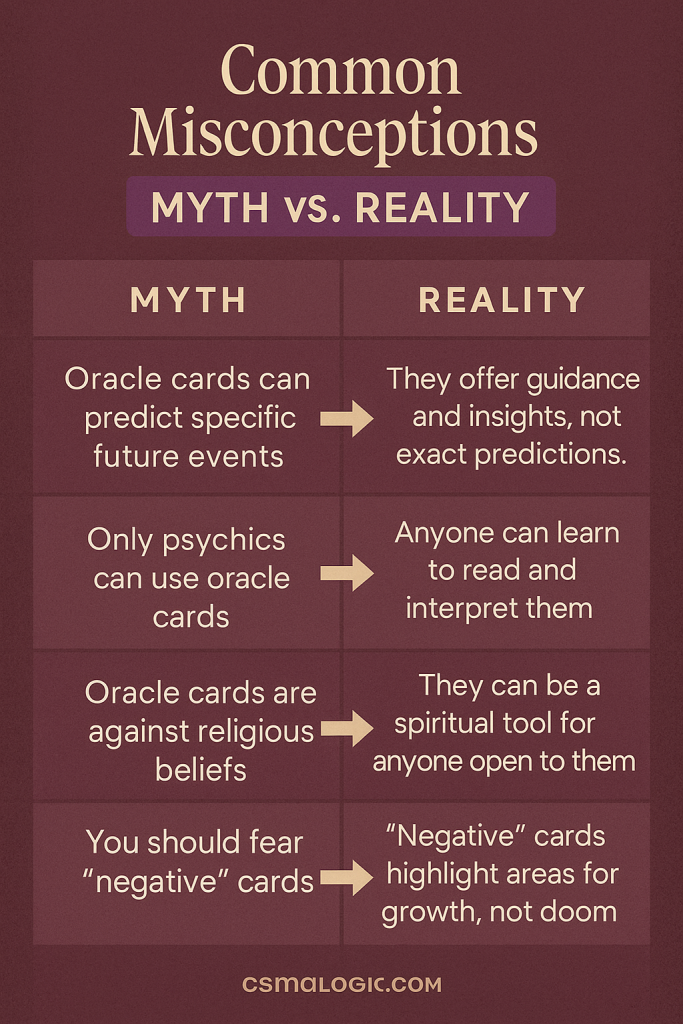
Like anything mystical, oracle cards attract myths that need debunking.
Myth 1: Oracle cards predict exact events. Reality: They show energy patterns and possibilities, not fixed scripts.
Myth 2: Only psychics can read them. Reality: Anyone can learn to read oracle cards, but psychics amplify accuracy by layering intuition and spiritual connection.
Myth 3: Oracle cards are just pretty pictures. Reality: They’re portals for symbolism. Many decks are designed with archetypal art that activates the subconscious.
Myth 4: A “bad card” means doom. Reality: Oracle decks are rarely framed in negatives. Even challenging cards carry constructive messages like “Release” or “Transformation.”
Example: A woman panicked when she pulled a “Storm Warning” card. Her psychic reframed it: “This doesn’t mean disaster—it means prepare. When you pack an umbrella, the rain doesn’t scare you.” The client left not anxious, but empowered.
Section 6: How Psychics Use Oracle Cards Differently
When you read oracle cards for yourself, you’re drawing from your personal intuition. When a psychic reads them, something extra is at play—they’re blending the card imagery with their clairvoyant or clairsentient impressions. The card becomes a trigger, not the whole story.
For example, a psychic may pull a “Journey” card for you. On its own, it might suggest travel or a new path. But if the psychic also feels a tingling in their solar plexus, they might say, “This isn’t just about moving physically—it’s about reclaiming your confidence and independence.” The card acts like a doorway to deeper psychic impressions.
This layering is what makes psychic readings so powerful. The card confirms the intuitive download, and the intuitive download gives the card specific context. Without that blend, you might only scratch the surface.
Example: A client once received the “Transformation” card. On her own, she thought it meant personal growth. Her psychic added: “I sense a career pivot within three months, connected to your throat chakra—speaking, teaching, or leading.” Sure enough, she was offered a teaching position shortly after.
Section 7: Choosing the Right Oracle Deck
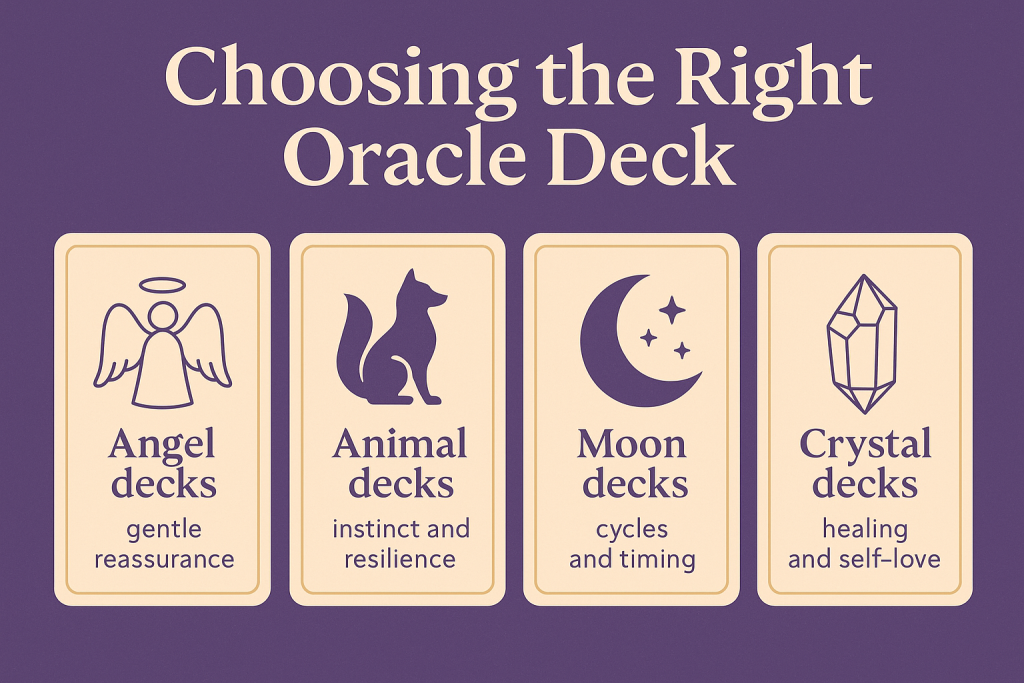
Oracle decks are as diverse as music genres. There are angel decks full of soft, reassuring messages. There are animal decks that channel instincts and archetypes. There are moon cycle decks for those who sync their lives to lunar rhythms. And there are affirmation decks that act more like daily pep talks.
The key to choosing? Let the deck choose you. If the artwork gives you goosebumps or you can’t stop thinking about it, that’s your deck. You don’t need to intellectualize the decision—your intuition knows what will speak to your soul.
Example: A client recovering from heartbreak once walked into a bookstore and felt her eyes glued to a crystal-themed oracle deck. She bought it, and the first card she pulled was “Rose Quartz: Love Yourself First.” It was exactly the message she needed at the time.
Green Witch Living suggests that oracle cards shine during tough times because they provide gentle, motivational guidance when you’re most in need of reassurance (Green Witch Living). Choosing a deck that resonates emotionally ensures the guidance lands in your heart, not just your head.
Section 8: Oracle Cards in Everyday Life
Oracle cards aren’t just for “big life questions.” They can be part of your daily routine, like coffee or meditation. Many people pull one card each morning to set an intention. Imagine starting the day with a message like “Trust Your Inner Compass” or “Release and Flow”—suddenly, traffic or emails feel less daunting.
Couples sometimes use oracle decks to spark conversations. Instead of arguing over chores, they might draw a card together: “Patience.” Cue a laugh, a sigh, and a gentler chat. Families, too, create rituals. I’ve seen parents let kids draw a weekly oracle card at Sunday dinner, turning it into a family reflection practice.
Oracle journaling is another favorite. Pull a card, write about how it relates to your life, then revisit later. It’s like having a conversation with your future self. And for spiritual routines, pairing oracle cards with meditation or moon rituals adds a layer of insight that feels grounding yet magical.
Section 9: Real-Life Examples of Oracle Insights
Stories bring the cards to life.
One client drew a “Release” card three nights in a row. She laughed it off until she realized she’d been ignoring signs to leave her toxic job. The card confirmed what her gut already knew—it was time to walk away.
Another empath leaned on oracle readings while dating. Before each new date, she’d pull a card. If she drew “Boundaries,” she reminded herself not to overgive. She later said the cards helped her maintain self-respect in ways she never had before.
A family I know created a Friday ritual where everyone pulled one oracle card to set intentions for the week ahead. The father once pulled “Adventure,” so they all decided to try a new hiking trail that weekend. What began as a spiritual practice became a bonding tradition.
Medium writer Dina Nussupova even noted that oracle and tarot cards can support mental health by validating what you’re already feeling and gently nudging you toward growth (Medium).
Section 10: Why Psychics Recommend Oracle Readings for Beginners
If you’re new to the world of divination, oracle cards are like the friendly neighbor who greets you with cookies instead of a rulebook. Tarot can feel intimidating with its 78-card system and centuries of layered symbolism. Oracle decks, on the other hand, are approachable. You can shuffle, pull one card, and instantly get a clear, gentle message without memorizing archetypes or spreads.
That’s why psychics often recommend them as a starting point. They help people build trust in their own intuition. Pulling a card that says “Courage” right before a job interview is not a prediction—it’s a mirror reminding you of your inner strength. Over time, these affirmations reinforce confidence and self-trust.
Psychics also know oracle decks reduce fear. There are no “scary” cards like The Tower or Death. Even challenging messages are framed as growth opportunities, such as “Let Go” or “Transformation.” Beginners find this encouraging rather than intimidating, which makes it easier to stay open to guidance.
Example: A client who always felt nervous about psychic tools tried an oracle deck first. Her first pull was “Healing.” She later admitted, “If I had seen a Death card on day one, I would have run. Instead, this felt like a hug.” That one gentle card opened the door to deeper exploration with tarot and psychic readings later.
Section 11: Oracle Readings Across Cultures and Traditions
Oracle cards may feel modern, but they’re part of a universal human impulse: the search for meaning through symbols. Cultures across history have created their own versions.
The Chinese I Ching uses hexagrams to map energy patterns and decisions. Norse runes use carved symbols for guidance, blending language and mysticism. Ancient Greeks turned to oracles at Delphi, where priestesses interpreted divine messages. Even dream interpretation across cultures shows the same archetypal need—using imagery to reveal hidden truths.
Oracle cards fit right into this lineage. They’re just the contemporary packaging for an ancient practice: consulting symbols to understand the unseen.
Very Well KC notes that tarot, oracle, runes, and numerology all share a common role—they act as tools for reflection, intuition, and deeper self-connection (Very Well KC). Oracle cards are simply one of the most accessible bridges between old traditions and modern seekers.
Section 12: Taking the Next Step – Blending Oracle with Psychic Guidance
Reading oracle cards on your own is like dipping your toes in the pool—you get a feel for the water. Having a psychic interpret them with you is like diving in with a guide who knows the currents. The images you pull can hold multiple layers of meaning, and a psychic helps uncover which layer applies to your unique situation.
For example, you might pull an “Abundance” card and think, “Cool, maybe I’ll get a raise.” A psychic might add: “This isn’t just money—it’s emotional abundance, and I sense a deepening friendship entering your life within weeks.” The card is the spark; the psychic reading is the fire.
Psychics also weave together timing, energy patterns, and intuitive nudges. Oracle decks point to themes; psychics highlight the map. That’s why so many seekers leave a reading saying, “It’s like the cards knew me better than I knew myself.” In reality, it’s the blend of your intuition, the symbols, and the psychic’s vision working in harmony.
Conclusion: Oracle Cards as Soul Mirrors
Oracle cards are not fortune cookies, and they’re certainly not toys. They’re reflective tools that show us the truths hiding in plain sight. Across cultures and history, humans have turned to symbols for guidance. Oracle decks are simply the modern expression of this timeless practice.
Whether you’re pulling a daily card for clarity, journaling with a spread, or sitting with a psychic who deepens the message, oracle cards remind you of one thing: you are never without guidance. The answers may already be in your heart—the cards just help you see them clearly.
FAQ
What is an oracle card reading?
An intuitive session using themed cards to reflect your energy, clarify choices, and offer guidance.How are oracle cards different from tarot?
Tarot has a fixed 78-card system; oracle decks vary in card count, themes, and structure, making them more flexible.Do oracle cards predict the future?
They highlight energy patterns and likely paths. Your choices and timing still shape outcomes.Can beginners use oracle cards?
Yes. They’re beginner-friendly: pull one card, read the guidebook or your intuition, and journal insights.Why work with a psychic instead of reading solo?
Psychics blend the card message with clairvoyant/clairsentient impressions, adding context, timing, and nuance.What kinds of questions work best?
Open-ended ones: “What energy surrounds my career/relationship?” vs. yes/no questions.How should I prepare for a reading?
Set a clear intention, hydrate, arrive open-minded, and bring a journal for notes.What happens during a reading?
The reader tunes into your energy, pulls cards in a spread, interprets symbols, and answers follow-up questions.How long does a typical session last?
Commonly 15–45 minutes for focused topics; longer sessions allow deeper exploration.Can oracle readings help with anxiety or overwhelm?
They can validate feelings and suggest next steps. They complement—never replace—professional mental-health care.Are certain decks better for love, career, or healing?
Yes. Love/angel decks support emotions, animal/crystal decks boost resilience, moon/elemental decks help with cycles.How often should I pull a card?
Daily for intention, weekly for themes, or whenever decisions arise. Avoid over-pulling for the same question.What if I get a “challenging” card?
Treat it as coaching, not doom. Ask: “What is this card inviting me to release, learn, or prepare?”Can oracle cards be wrong?
Cards reflect the moment. If the message feels off, you may need clarity, grounding, or a better-framed question.What’s the difference between oracle and affirmation decks?
Many oracle decks include guidance + imagery; affirmation decks focus on short empowering statements.How do psychics combine oracle with other tools?
They may layer in tarot, astrology, numerology, mediumship, and aura reading for a multi-angle view.Can I use oracle cards for relationships?
Yes. Ask about shared energy, personal patterns, and healthiest next steps for connection.How do I choose my first deck?
Let the art and theme call you. If it feels warm, curious, or tingly in your hands, it’s likely a good match.How do I cleanse or bless a new deck?
Methods include intention setting, gentle knocking, smoke cleansing, moonlight, or placing crystals nearby.What spreads are good for beginners?
Single card (daily insight), three-card (past/present/future or situation/action/outcome), and weekly theme spreads.Can oracle cards support creative blocks?
Yes. Prompt: “What wants expression now?” Pull a card and free-write for five minutes about its imagery.How do I ask better questions?
Shift from prediction to empowerment: “What aligns me with my goal?” “What am I not seeing?”Are remote readings effective?
Yes. Energy isn’t limited by location; many clients prefer video or phone for comfort and convenience.What if two readers give different messages?
Different angles can be complementary. Look for shared themes and choose the guidance that resonates most.How can I integrate a reading after the session?
Journal key messages, set one micro-action, and schedule a check-in with yourself in 7–14 days.What ethical standards should a reader follow?
Consent, confidentiality, non-medical/legal claims, and respect for your agency and timing.Can oracle cards help with timing?
They hint at phases; psychics may add timing impressions (e.g., lunar cycles, seasons, numerological windows).Do I have to be spiritual to benefit?
No. Curiosity and self-reflection are enough. Treat cards as mirrors for decision-making.How do I avoid becoming dependent on cards?
Use them to clarify choices, then act. Set limits (e.g., one pull per topic per week).When is the best time to book a psychic oracle reading?
At crossroads, during big transitions, or when your intuition is loud but you need confirmation and next steps.

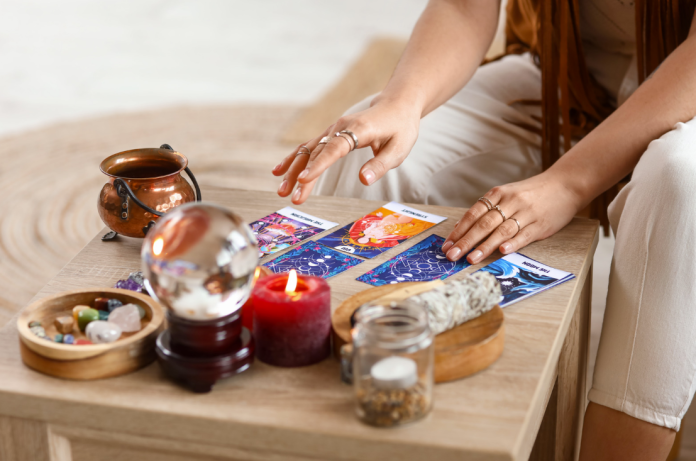
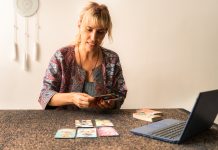

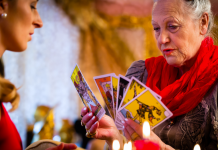
This article beautifully captures the essence of oracle card readings. It’s enlightening to see how these decks can provide such profound guidance and clarity. The comparison with tarot cards is particularly insightful, helping readers understand the nuanced differences and applications. I truly believe in the power of intuition, and this practice seems to be an excellent tool for fostering personal growth and self-awareness.
It’s fascinating how cultures have developed various tools for divination. Oracle cards, distinct from tarot, offer a more fluid and intuitive approach that can be very empowering for those in search of personal insights.
Ah yes, because who needs years of therapy and self-reflection when you have a deck of cards with pretty pictures. Truly the pinnacle of human problem-solving.
This article brilliantly explains the intricate nature of oracle card readings. The inclusion of both practical guidance and spiritual insights makes it a comprehensive guide for anyone seeking to deepen their connection with their intuition.
The article does a good job explaining how oracle cards can help with personal growth and decision making. It’s a tool that seems both spiritual and practical.
Interesting, but isn’t it just a glorified form of psychological suggestion? I mean, the cards provide guidance based on what the reader wants to see in the symbols and images.
The article provides a detailed description of oracle card readings and their uses. It’s interesting to see how they can be combined with other tools like crystals and tarot cards for enhanced guidance.
Yes, I agree. The combination of different divination tools seems to provide a more comprehensive reading.
Indeed. It’s fascinating how these tools can be used together to gain deeper insights.
While the article does a commendable job of explaining oracle card readings, it tends to skirt around the scientific skepticism that surrounds such practices. The reliance on intuition and spiritual guidance, while possibly beneficial for some, lacks empirical support. It is essential to balance personal belief with critical thinking, especially when it comes to making important life decisions. Skeptics could argue that the so-called ‘guidance’ is nothing more than the reader’s interpretations, which can be highly subjective. Hence, while oracle card readings may offer some comfort, they should not be mistaken for concrete advice.
I appreciate the distinction made between oracle decks and tarot decks. It clears up a lot of confusion for those new to divination practices.
The emphasis on preparing oneself before an oracle reading is very practical. Being relaxed and focused can definitely enhance the experience.
Oh please, more pseudoscience masquerading as spiritual guidance. Using symbols and pictures to make life decisions is hardly reliable or scientific.
It’s interesting to note that oracle cards can connect with the spiritual world and offer guidance at any time. The flexibility of this divination tool is quite appealing.
This article provides a comprehensive overview of oracle card readings and their practical applications. It’s fascinating how oracle cards can be used to tap into one’s intuition and provide insight into major life decisions. The distinction between oracle and tarot cards is particularly informative, highlighting the diverse imagery and interpretative flexibility of oracle decks. For anyone looking to deepen their spiritual practice or gain perspective, this form of divination seems quite promising.